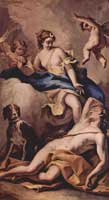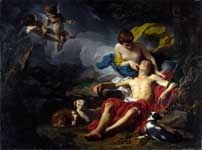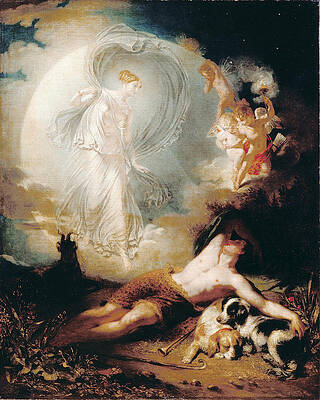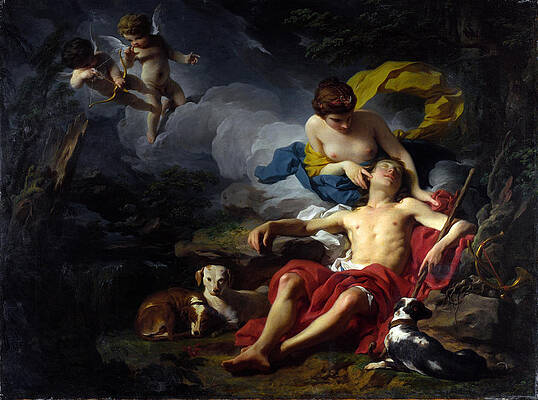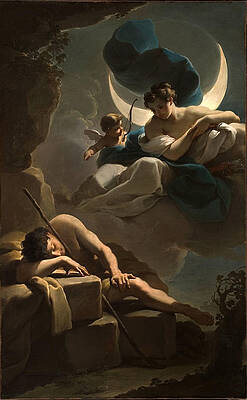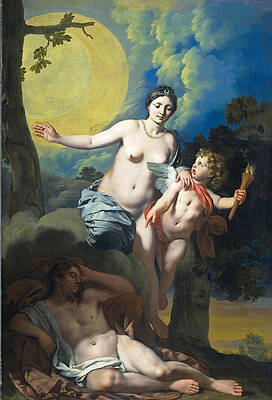.
In Greek mythology, Endymion (Ἐνδυμίων) was a handsome Aeolian shepherd or hunter, or, in the version Pausanias knew,[1] a king, who ruled Elis in Asia Minor; Endymion was the son, perhaps with Aethlius or with Zeus himself, of the nymph Calyce. He was born in Thessaly but led a band of Aeolians and founded Elis.[2] Apollonius of Rhodes (Argonautica 4.57ff) is one of the many poets (compare Plato, Phaedo, sect. 72) who tell how Selene, the Titan goddess of the moon, loved the mortal, who was so beautiful that she asked Endymion's father Zeus to grant him eternal youth so he would never leave her. Alternatively, Selene loved so much how Endymion looked when he was asleep in the cave on Mount Latmos, near Miletus, in Caria; she entreated with Zeus that he might remain that way. Either way, Zeus blessed him by putting him into an eternal sleep. Every night, Selene visited him where he slept. Selene and Endymion had fifty daughters called the Menae and the Ethiopian ruler Memnon.
The mytheme of Endymion being not dead but endlessly asleep, which was proverbial[3] ensured that bas-reliefs of Endymion and Selene were popular subjects for sarcophagi in Late Antiquity, when after-death existence began to be a heightened concern.
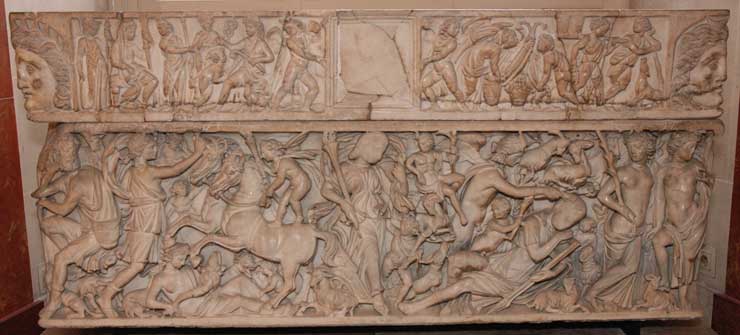
Endymion and Selene. Panel of a marble sarcophagus, early 3rd century AD. Found in 1806 at Saint-Médard d'Eyrans, France. Dimensions H. 95 cm (3 ft. 1 in.), W. 209 cm (6 ft. 10 in.), D. 60 cm (1 ft. 11 in.) , Credit line Purchase, 1817 , Accession number Ma 1335 , Location Department of Greek, Etruscan and Roman Antiquities, Denon, ground floor, room 26
The Louvre example above is one of this class.
The dithyrambic poet Licymnus of Chios tells a different tale[2], in which Hypnos, the god of sleep, is the one who is in love with the boy's beauty, and grants him open-eyed sleep, the better to enjoy the sight of his face.
Endymion also had a son named Aetolus, the King of Elis. Later, he ruled Aetolia, which was named after him. Endymion had another son, Epeius, who won his father's kingdom by beating his brothers in a race.[4]
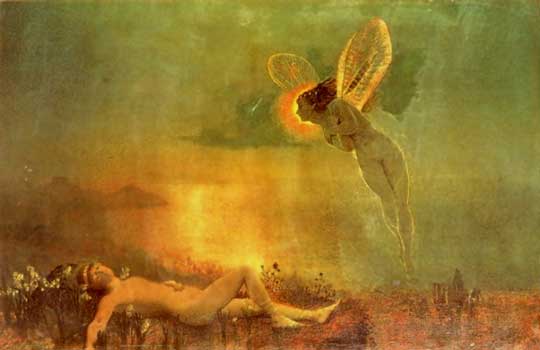
Selene visits Endymion on Mount Latmus, John Atkinson Grimshaw 1879
Pliny the Elder mentions Endymion as the first human to observe the movements of the moon, which (according to Pliny) accounts for Endymion's love. (See Pliny's Naturalis Historia Book II.IV.43.)
Some believe that he was the personification of sleep, or the sunset (most likely the last one as his name means "to dive in" [Greek en in, and duein dive), which would imply a representation of that sort. Latin writers explained the name from somnum ei inductum, the "sleep put upon him" (Graves, 1960, 64.b.note 2).
The myth of Endymion was never easily transferred to ever-chaste Artemis, the Olympian associated with the Moon. In the Renaissance, the revived moon gooddess was Diana, and the myth was attached to her.
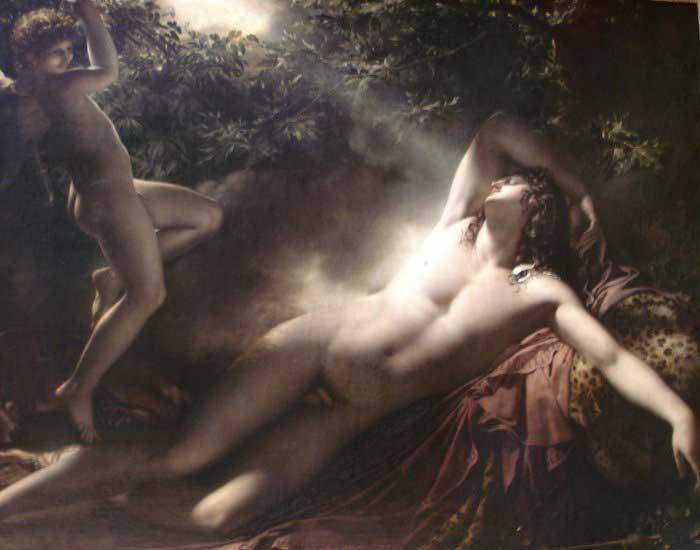
Endymion (Le Sommeil d'Endymion), Anne-Louis Girodet-Trioson, 1792, musée du Louvre (INV 4935)
Endymion, John Wood
Diana and Endymion, Luca Giordano
Diana and Endymion, Benedetto Gennari
Diana and Endymion, Pierre Subleyras
Selene and Endymion, Ubaldo Gandolfi
Selene and Endymion, Gerard de Lairesse
Selene and Endymion, Nicolas Poussin
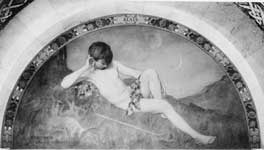
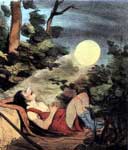
Endymion, Honore Daumier, a parody. Endymion "kissed" by the moonlight (there is no Selene).

The Vision of Endymion , Sir Edward Poynter

Diana and Endymion, Walter Crane
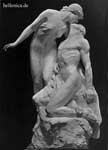
Notes
- ^ Pausanias, v.8.1; viii.4.2-3.
- ^ "Calyce and Aethlius had a son Endymion who led Aeolians from Thessaly and founded Elis. But some say that he was a son of Zeus. As he was of surpassing beauty, the Moon fell in love with him, and Zeus allowed him to choose what he would, and he chose to sleep for ever, remaining deathless and ageless." (Bibliotheke 1.7.5.
- ^ Sir James George Frazer, ed., Apollodorus, Library and Epitome [1].
- ^ "Endymion had by a Naiad nymph or, as some say, by Iphianassa, a son Aetolus, who slew Apis, son of Phoroneus, and fled to the Curetian country. There he killed his hosts, Dorus and Laodocus and Polypoetes, the sons of Phthia and Apollo, and called the country Aetolia after himself." (Bibliotheke, 1.7.6).
J. Colton, The Endymion Myth and Poussin´s Detroit Painting. In : Journal of the Warburg and Courtauld Institutes 30 (1967), 426-430.
342 Endymion asteroid
Links
- 'Diana and Endymion' at the Walker Art Gallery, Liverpool
- Endymion by Anne-Louis Girodet de Roussy-Trioson at the Louvre
See also : Greek Mythology. Paintings, Drawings
| Ancient Greece
Science, Technology , Medicine , Warfare, , Biographies , Life , Cities/Places/Maps , Arts , Literature , Philosophy ,Olympics, Mythology , History , Images Medieval Greece / Byzantine Empire Science, Technology, Arts, , Warfare , Literature, Biographies, Icons, History Modern Greece Cities, Islands, Regions, Fauna/Flora ,Biographies , History , Warfare, Science/Technology, Literature, Music , Arts , Film/Actors , Sport , Fashion --- |
Retrieved from "http://en.wikipedia.org"
All text is available under the terms of the GNU Free Documentation License

